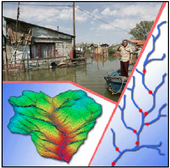Highlight
Tisza River Connectivity: Past Losses, Present Dynamics, and Future Opportunities
Achievement/Results
U.S. National Science Foundation (NSF) Theme: IGERT: Multidisciplinary Team-Based Training in Watershed Science and Policy
Southern Illinois University Principal Investigators: Nicholas Pinter (Director, Geology); Chevalier (Co-Director, Engineering); Whiles (Zoology), Lant (Geography); Baer (Plant Biology)
Summary of NSF Theme:
“IGERT” is the U.S. National Science Foundation’s initiative in “Integrative Graduate Education, Research, and Training,” which is the agency’s flagship program for fostering cuttingedge science that crosses traditional disciplinary boundaries.
The goals of the Southern Illinois University (SIU) IGERT program in Watershed Science and Policy are (1) to cultivate a new generation of watershed science and management graduates trained in solving complex, real-world problems, and (2) to create a new model for graduate education centered on team-based collaboration across traditional disciplinary boundaries. Our IGERT PhD fellows collaborate as a team in constructing a comprehensive assessment and management plan each year for one river basin. Our fellows have worked in the Cache watershed (Ramsar wetland of international significance located in Illinois), the Atchafalaya basin, and are now starting the capstone project in the Tisza River basin.
Tisza River Connectivity Research Project
Two key program features of the SIU IGERT highlighted to NSF were: (1) exposure to transboundary rivers and international watershed science and issues; and (2) graduates trained in international best practice in integrated watershed management. The centerpiece of our international efforts is a large research collaboration with European partners focused on past, present, and future “connectivity” of the Tisza River.
The Tisza is the largest tributary of the Danube River, and is a focus of several scientific and diplomatic initiatives as Tisza basin countries harmonize with European Union directives and begin to address long-term management challenges. The Tisza is one of the world’s best documented case studies of losses in river-system connectivity, primarily the result of 19th-century dewatering of the Great Hungarian Plain, as well as 20th century dam and weir construction and other activities.
The IGERT group is currently conducting research in the Tisza basin, collaborating with host scientists to (1) rigorously quantify past connectivity losses, (2) characterize present-day system dynamics, and (3) model one or more specific reconnection opportunities.
River system “connectivity” is a paradigm that has been gaining widespread currency in both science and management contexts over the past several years. Connectivity refers to the degree that a hydrologic system is open to exchanges of water, solutes, sediment, organisms, and energy. Recent research and management experience has highlighted the centrality of these fluxes to all of the functions of a river system, from ecological diversity to removal of human waste and pollutants to flood control to economic resources and services of river systems.
Connectivity operates both longitudinally within a river system – meaning between upland watershed lands and the channel network – as well as laterally between the river channel itself and adjacent floodplain and broader wetlands areas. Floodplain connectivity is particularly important to the functioning of a river system and the services that the system provides to the watershed’s human population and economy. Floodplains are some of the earth’s most productive lands, with global floodplain services estimated at US $19,580 ha-1yr-1, compared to $969 ha-1yr-1 for forests and $92 ha-1yr-1 for cropland (Constanza et al., 1997). But these environments have been widely degraded and disconnected over time as a result of wetland drainage, flood control, navigation engineering, and channel stabilization. In practical terms, recognition of connective dynamics can be the difference between (1) rivers serving as benign and stable hosts to both the natural environment and human populations, vs. (2) damages that can significantly outweigh the original benefits and motivations for disconnecting the system. In the Netherlands, for example, €2.3 billion is now being spent on reconnecting portions of the Rhine River and its distributaries to the surrounding landscape, as an investment to prevent up to €165 billion in potential flood losses. Less developed countries have the advantage that much smaller investments can often be leveraged to avoid large-scale impacts of river disconnection before such changes occur.
This project’s coordinating partner is the United Nations-based International Commission for the Protection of the Danube River in Vienna. With the help of the ICPDR, our 7 IGERT fellows arrived in January of 2013 in 4 different European countries, including 3 different Hungarian universities (PI Pinter and central site is in Budapest, at Eötvös Lóránd University). Several European partner scientists traveled to the U.S. during project planning, and a number of U.S. researchers are now scheduled to visit partner scientists on this project. The initial period of work on the Tisza system will last 6 months, and it is anticipated that most of the IGERT fellows will continue this research through the remaining 2-3 years of their dissertation projects.
Address Goals
The goals of this U.S.-European partnership are (1) to help quantify past losses of connectivity in the Tisza system, (2) to better understand present-day dynamics of the disconnected Tisza, and (3) to identify and model opportunities for beneficial and costeffective reconnection in the future.







